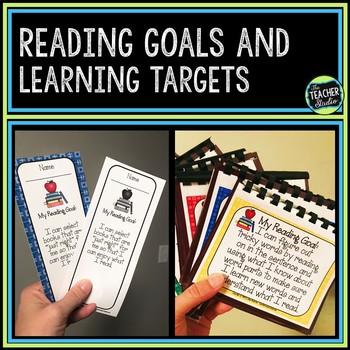Reading Goals: Reading Learning Targets for Focused Instruction
- PDF
Description
If you are like me, you know that all of your students are unique in their reading learning needs. Although you may teach the same reading minilesson to all students, you will need to do more specialized instruction with some of your students either individually or in small groups. This resource is jam-packed with specific learning goals/learning targets that cover a wide variety of reading lessons that you may need to work on with certain students.
Best practice says that students are more likely to achieve a learning target if they know what the goal is—so this resource is geared toward helping with that.
The learning targets are clustered into categories as listed below:
*How I sound when I read (fluency/accuracy) 7 learning targets
*How I stay focused when I read (reading habits) 7 learning targets
*How I monitor myself when I read 5 learning targets
*How I comprehend informational texts 9 learning targets
*How I comprehend fiction texts 13 learning targets
*How I share my ideas about reading (oral/written) 10 learning targets
Each cluster has different colored background to make it easy to identify. Every learning target in that section has:
*A full page version of the target that can be printed out and displayed during a group/individual meeting.
*A full color page of 3 bookmarks that can be printed and cut and given to students to use. Many ask them to record places in the text where they practiced the skill.
*A black and white version of the bookmark to save on ink.
*Information about each section with instructional hints and background information
SUGGESTIONS FOR USE:
*Print off the full page versions, put in sheet protectors, and put in a binder. Just use post it notes to mark the different pages you are using with groups to easily flip back and forth!
*Print the full page versions 2 per page and use a small three ring binder to keep them.
*Project the full page versions when teaching full class lessons
*Have students glue the bookmarks they “master” in their reading notebooks.
*Tape/glue bookmarks into an assignment notebook to show families what skills are being worked on.
- - - - - - - - - - - - - - - - - - - - - - - - - - - - - - - - - - - - - - - - - - - - - - - - - -
Looking for other reader's workshop resources? Try these!
- - - - - - - - - - - - - - - - - - - - - - - - - - - - - - - - - - - - - - - - - - - - - - - - - -
- - - - - - - - - - - - - - - - - - - - - - - - - - - - - - - - - - - - - - - - - - - - - - - - - -
All rights reserved by ©The Teacher Studio. Purchase of this resource entitles the purchaser the right to reproduce the pages in limited quantities for single classroom use only. Duplication for an entire school, an entire school system, or commercial purposes is strictly forbidden without written permission from the author at fourthgradestudio@gmail.com. Additional licenses are available at a reduced price.





